Circular knitting needles are sold using two measurements. There’s the circumference of the needle tips and the total length of the needles. If you have a large enough collection, though, it can be hard to remember those measurements for each set. If you need to know how to measure your circular knitting needles, this post is for you.
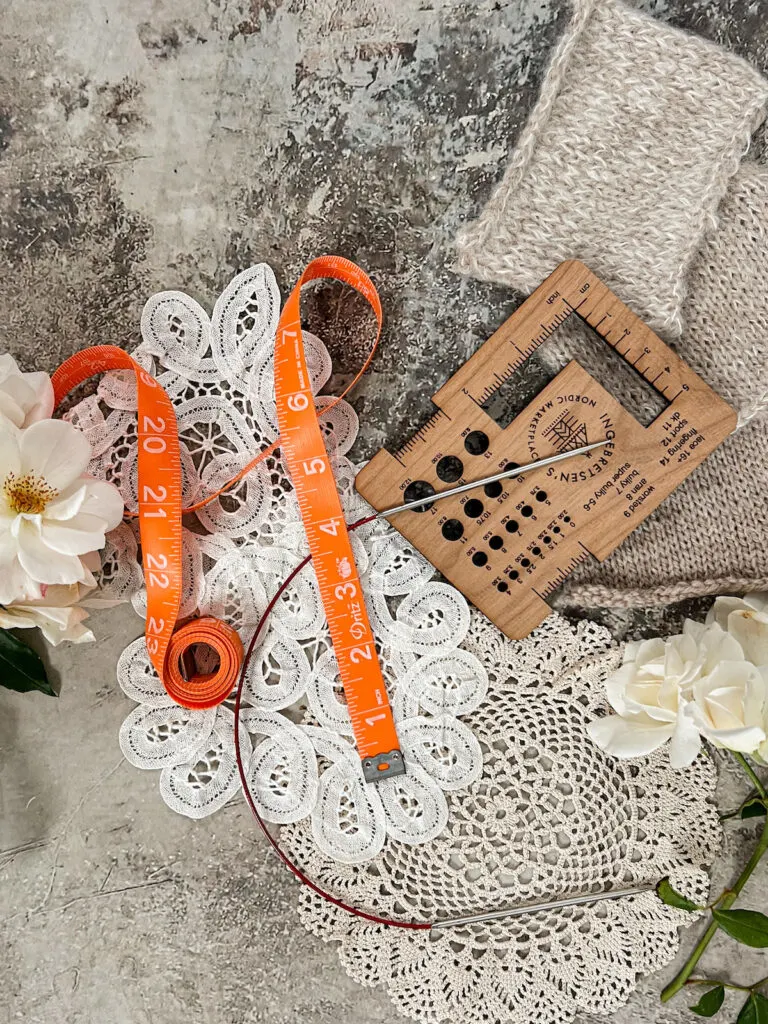
Why You Might Need to Measure Your Circular Knitting Needles
When most knitters first start out, they have a couple sets of needles, and that’s it. When your collection is small, you can pretty easily remember which needles are which size and which length.
But as your collection grows, it can be harder to keep track of these things. What’s more, as you use your circular needles more often, many of the identifying marks can wear away over time.
And if you’re like me, well, your storage system isn’t exactly set up for keeping track of all that information.
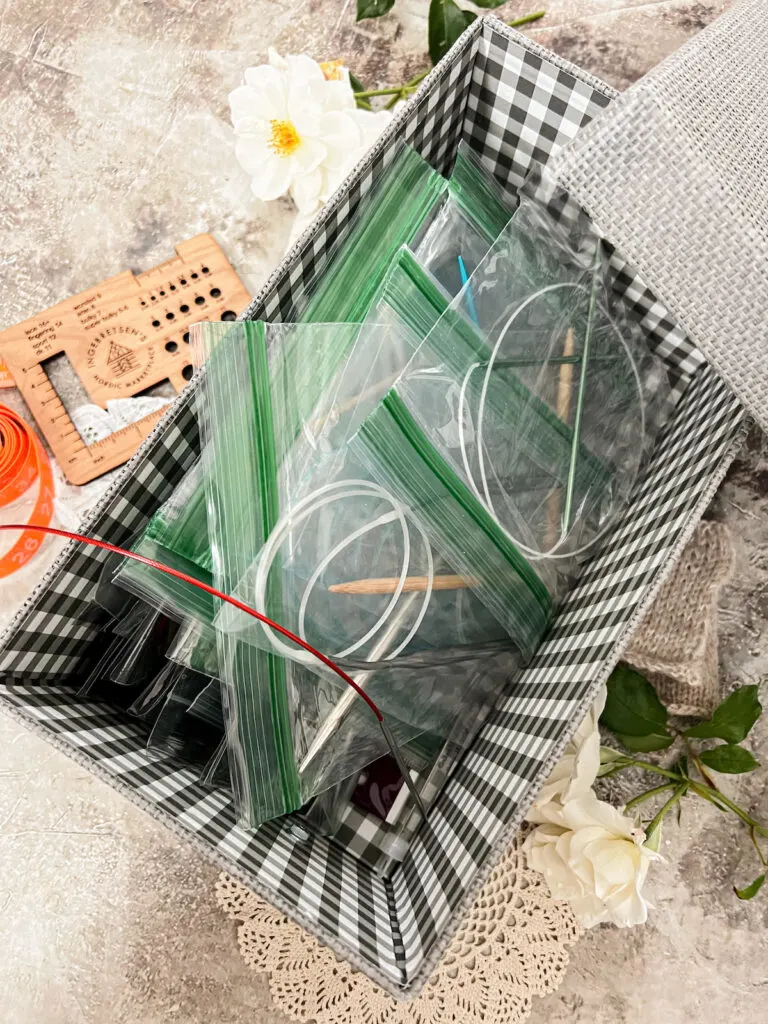
Thankfully, you don’t have to memorize every detail about each set of needles you own. You also don’t have to keep meticulous records and store them in perfect order. All you need are a couple tips for measuring your needles.
Circular needles are useful for all sorts of projects, from larger projects where you want to distribute the weight more ergonomically to projects with small circumferences where you really, truly do not want to use double-pointed needles. You’ll probably end up using them a lot in your knitting projects. As a result, it’s a good idea to pick the right set before you cast on.
How to Measure the Length of Your Circular Knitting Needles
Let’s look at the first measurement we’ll need to know: length. Circular knitting needles come in lots of different lengths, and it’s important to pick the size the pattern calls for. Unlike with straight knitting needles, the length of a circular needle can’t be calculated just by measuring the tips themselves.
So when a knitting pattern says you need a set of 24″ circular needles, for example, what is it really saying? Well, it’s talking about the total length from the tip of one needle, along the cord, to the tip of the other needle.
To get an accurate length measurement, simply do the following. First, take a tape measure, and place it at one end of your circular needle. Stretch that needle out straight along the length of your tape measure. Once you reach the other end of your circular needle, take note of where that tip is on the tape measure. There’s your length.
If you’re using a set of interchangeable needles, this complicates things just a bit. Those sets have needle tips in identical lengths and several different cable lengths. You’ll need to take this into account when picking out the cord length to attach to your needle points.
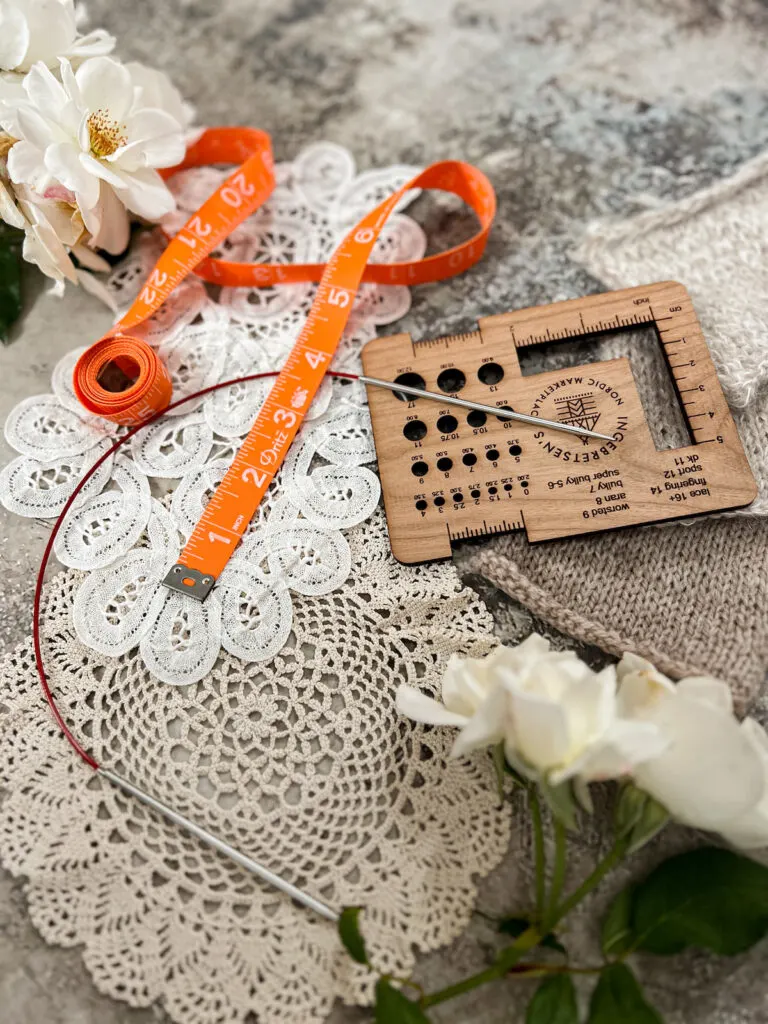
In other words, if the pattern calls for a 24″ set of needles, don’t pull out one where the length of the cable is marked as 24″. Instead, think first about the length of the needles you’ll be attaching to the cord. If each needle tip is 5″ long, then 10″ of your project is already taken up by the needle tips. You only need a cable that’s 14″ long.
Different interchangeable circular needles come with tips in different sizes, so it’s important to know how long your needle tips are. Longer needles will require a shorter cable to get the same total length as shorter needles with a longer cable. The Addi Click Lace Tips, for example, come in both 5.5″ and 3.5″ lengths.
How to Measure the Size of the Tips on Your Circular Knitting Needles
The second key measurement for circular needles is the circumference of the needle tips. That tells you how big around those tips are. By extension, it also tells you what gauge you’re likely to get when using those needles with a particular type of yarn.
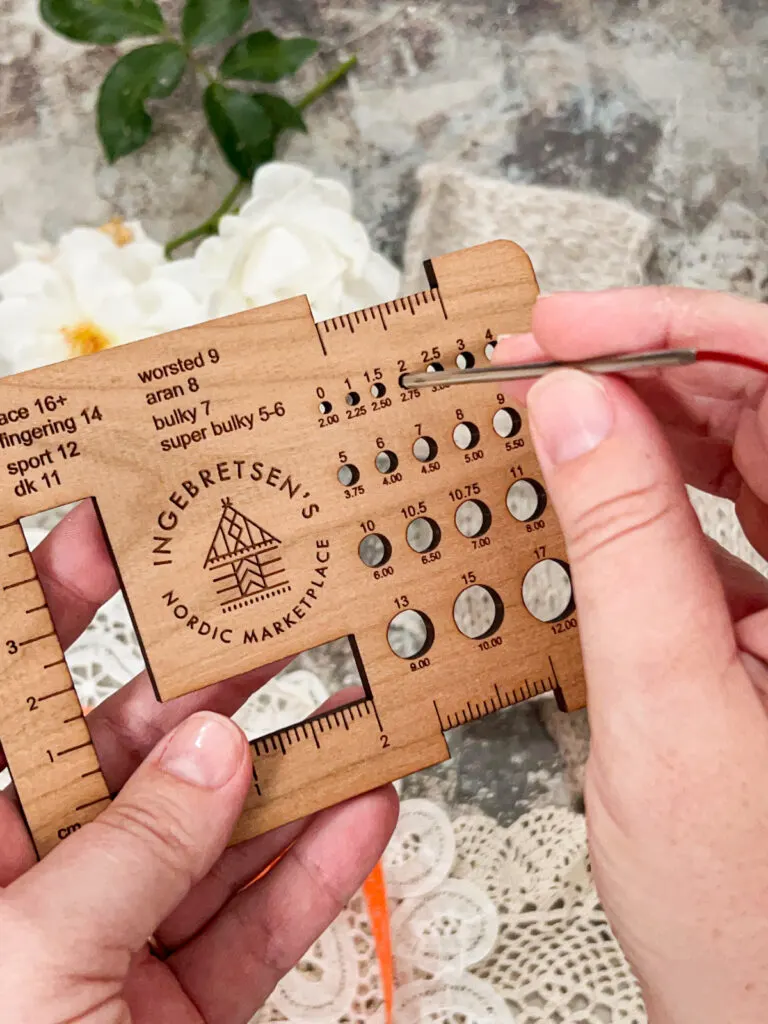
Sometimes a needle will have the size engraved or printed on it. Sometimes, though, it doesn’t, and sometimes that label gets worn away. If that’s the case, you’ll need to figure out the size of the needle another way.
The easiest way to do it is with a knitting needle gauge finder. These come in metal, wood, and plastic varieties, and they have lots of little holes. You stick your needle in until you find the last hole it can comfortably slide into. That’s the size of the needle. If you hit a hole where the needle can’t go in all the way, that’s too small. You should go up to the next size.
Sometimes, we have a gauge finder that only shows sizes in one system, but we have a pattern that labels sizes another way. For example, you might have a needle sizer that labels each different needle size in millimeters, but you have a pattern calling for needles in US sizes.
Don’t worry. I’ve got you covered. Here’s a knitting needle size chart with conversions between a few different sizing conventions.
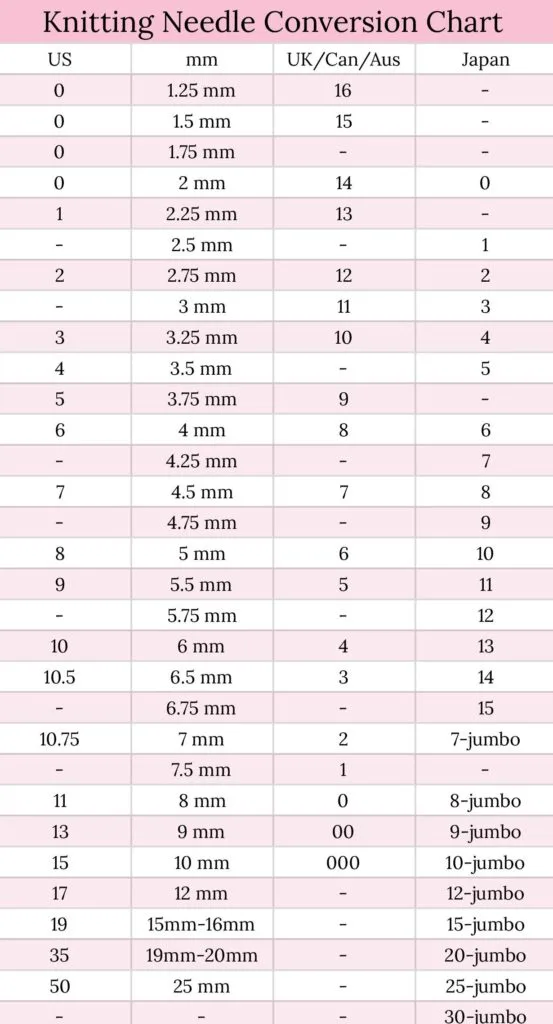
What Length of Circular Knitting Needles Should You Use?
Choosing the right length of circular knitting needle is a matter of hitting the sweet spot. Too long, and you won’t have enough stitches to go all the way around the needles (this is a crisis if you’re trying to knit in the round). Too short, and your stitches will be crammed onto the needles, which makes your knitting experience uncomfortable.
Even if you’re knitting flat, you’ll still want to avoid the perils of a circular needle that is too long or too short. A too-short needle will have the same problem if you’re trying to cram a large number of stitches on it. If your needle is too long, you’ll have a lot of unused flexible cord between the needle tips. That cord will bang and scrape against anything and everything while you’re working. This one is a personal pet peeve.
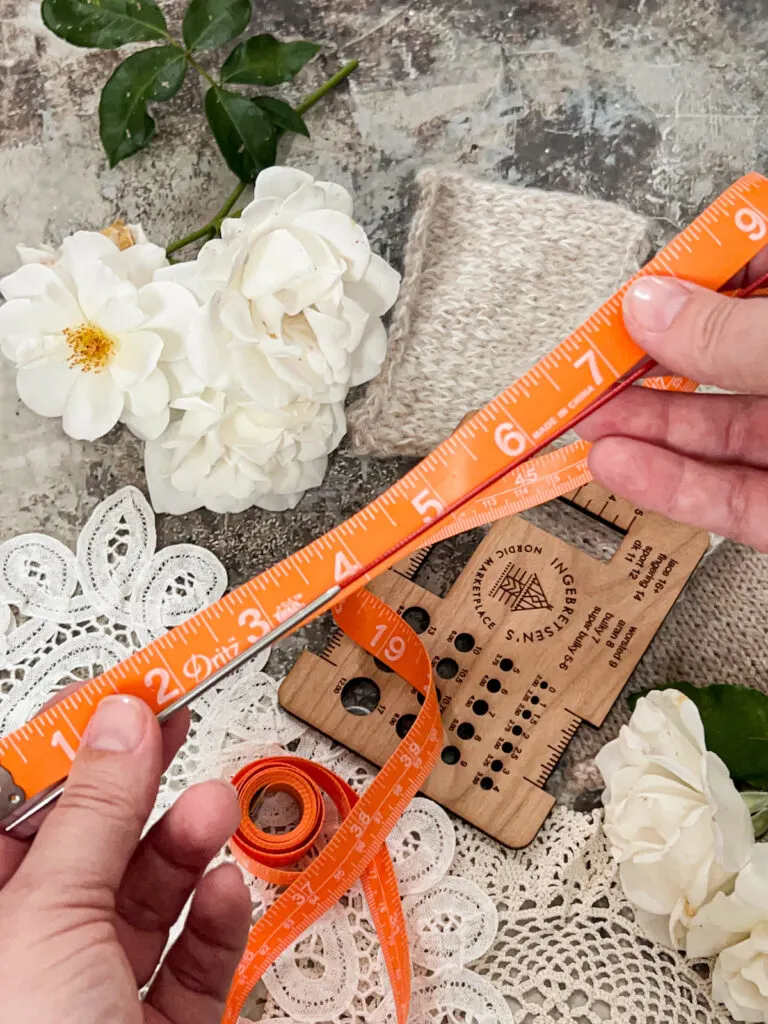
So how do you know where the sweet spot is? Well, take a look at the projected finished dimensions of your project. If you’re knitting in the round, the pattern should tell you either the circumference of that section (look at the schematic for garments if you’re working on a sleeve) or it should tell you the width laid flat. If it’s the latter, double that for the circumference of your knitting project.
Once I know the circumference of my project, my general rule is that I choose a needle length one increment down from the dimensions of my project. Here’s what I mean.
If the needle lengths I have available are 16″, 24″, 32″, and 40″, and I am knitting a hat that will have a 22″ circumference, I’m going to choose the 16″ needle. The 24″ needle will be too long, and my stitches won’t stretch around the needle. Likewise, if I am knitting a sweater from the bottom up with a 44″ circumference, I’ll choose the 40″ needle.
Think of it like the Price is Right: you generally want the needle length closest to your metaphorical 100 without going over.
If you’re knitting flat, the guidelines are relatively similar, but you can also use a needle that’s slightly longer than your projected project dimensions. I wouldn’t use a set of 40″ circular needles for a 12″ swatch, but that’s mostly a matter of personal preference.
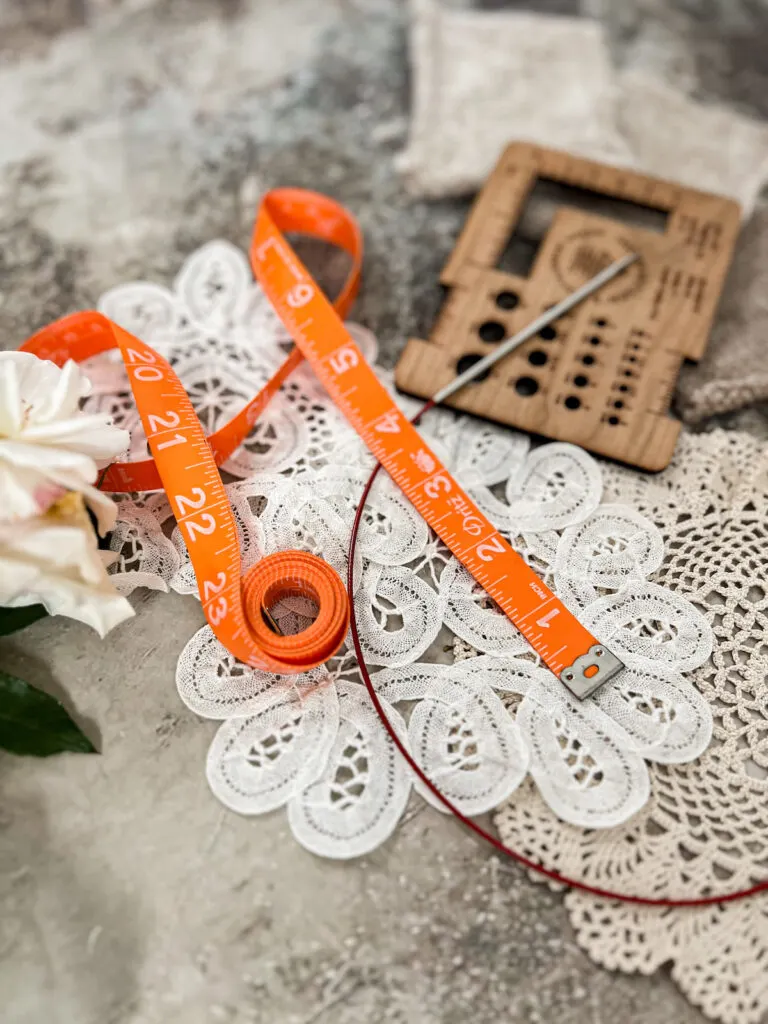
A Note About Short Circular Needles
If you’ve been hanging out here a while, you may have noticed I knit all my socks on tiny, 9″ circular needles. If it’s a sock, you can bet I’ve used my Chiaogoo US Size 1.5 (2.5 mm) short circular needles (affiliate link) to make it.
These short circular needles are really popular for socks, sleeve cuffs, and other small circumference items. Because they’re so short and the flexible cable needs enough length to bend in a circle, though, the needle tips are very small. This isn’t a problem for me, although it did take some getting used to.
Some knitters, however, have reported cramping or hand pain from working with these tiny circulars. Others just don’t like the feel of them. You’ll probably want to experiment for yourself before you buy one of the very cute, but fairly pricey, interchangeable sets.
What To Do If You Don’t Have the Right Length of Circular Knitting Needle In Your Collection
Knitting patterns will often tell knitters in the instructions that they need circular needles of various lengths. You might find that your pattern calls for one length of needle but the needle you actually have is a little bit shorter. This is more likely if you’re using interchangeable needle tips.
Don’t worry. As long as your needle length isn’t drastically shorter (say, 16″ when you need 24″), a couple inches usually won’t make much of a difference. If, say, you have 22″ from needle tip to needle tip instead of 24″ inches, you should still be fine for the majority of projects. Knit on, and have fun.